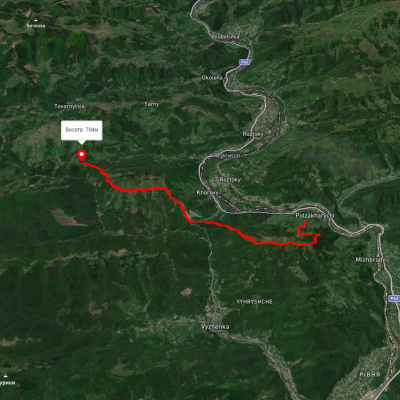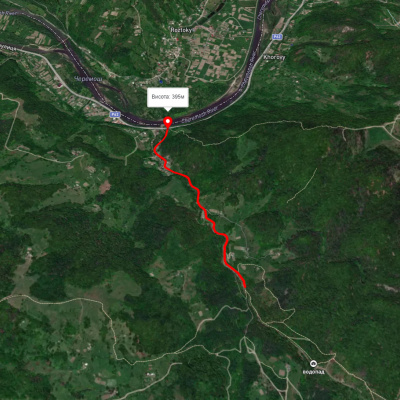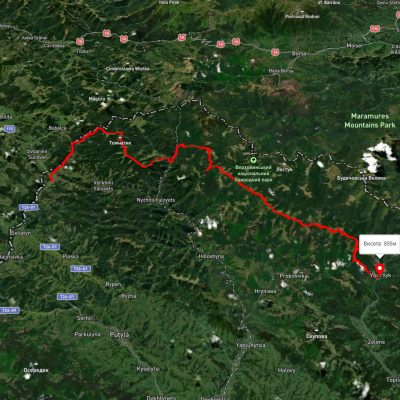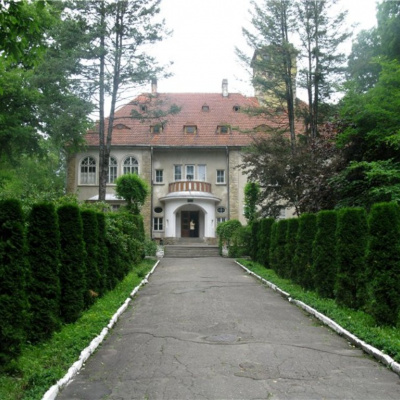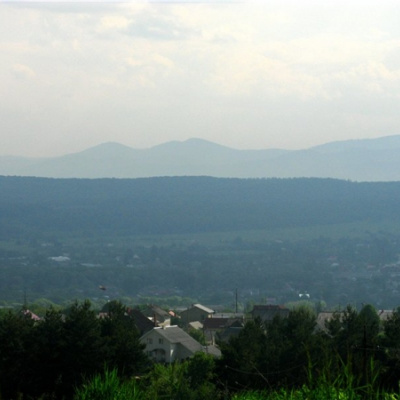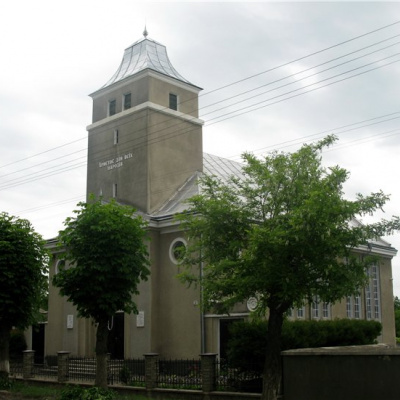Storozhynets
The name of the town of Storozhynets comes from the Old Slavic word "strozh", in Old Russian times - "storozh", which meant (as it does now) the protection of something or someone. The words "storozhnia" and "storozha" were used to mean a guard, a guard, an advanced detachment of troops. Derivatives of the above words are "storozhka", "storozhnia", "storozhnytsia" - a room where a guard, sentry, or advanced guard detachment lives. The word "storozhie" was also used to describe a remote corner, impassable swamps, marsh, swampy forest, impenetrable thickets, etc. Undoubtedly, the connection of this word with the Old Russian and Old Ukrainian languages is obvious.
Research by historians and philologists convincingly proves that the place name "storozhynets" comes from the word storozha, i.e. "guard" or "protection". Initially, this was the name of a watch fortification, which was probably located along the left bank of the Siret. Another confirmation of this is the name of the Storozynska hill, which was located near the town and was recorded on the map of 1886. Therefore, it is quite correct to say that the name of the town comes from the word "storozhynets" - in ancient times a fortified point where a guard was stationed, another version says that there was a watchpost of the ancient Rusyns.
In 1919, however, there was an attempt to rename Storozhynets to Flondoren after the wealthy Flondoren family, who lived in Storozhynets at least until World War II and had considerable political weight not only in Bukovyna but also in Romania, and who owned a large part of the present district center and its surrounding lands. By the way, the park near the boarding school, consisting of many species, often exotic trees, which was laid out by this family, is still known to ordinary Storozhyn residents as Fliondor Park. However, the new name did not catch on.
According to archaeological materials, the settlement of Storozhynets existed as early as the fourteenth and fifteenth centuries. This is evidenced by archaeological sites discovered in the early 60s of the last century by the famous Bukovyna archaeologist B. Tymoshchuk. The remains of the oldest settlement were found by the scientist almost in the center of the modern city, on the left bank of the Siret, on the territory of the district hospital (near the building of the former neurological department, which is located on the present-day Panteleimon Vidynivskyi Street). Among the archaeological finds at the excavation site were late medieval ceramics, pieces of clay coating, and animal bones.
Storozhynets was first mentioned in historical sources on February 18, 1448, in a charter of the Moldovan ruler Roman II (1447-1448), who granted the village to Mr. Petrea, Toma's son. It is well known that Petrea, Toma's son, served Roman II's father, the ruler Ilya I (1432-1433, 1435-1443). Consequently, at that time the settlement was subordinated to the Principality of Moldova. However, it should be noted that the settlement already existed at that time and had long-established boundaries. Historians believe that the settlement of Storozhynets could well have been part of the territory of the former Shypyn land, which was last mentioned in a charter of 1436. Later, Storozhynets was mentioned in a charter dated 1575 when defining the boundaries of Velykyi Kuchuriv. On the pages of documents in 1634, 1638, 1656, 1670, 1710, 1721, 1742, it is the subject of sale and purchase, the property of the Ropchanyl and Sorochanu families. From these charters we learn that the territory of the settlement of the same name also belonged to the community of Storozhynets village.
According to the charter of 1721, the Sorochan brothers were granted 10% of all profits from fields, hayfields, beekeeping, gardening, etc. The peasants grew millet, wheat, rye, barley, oats, peas, raised cows, pigs, sheep, horses, produced wax and honey, and were engaged in fishing and hunting. It is interesting to note that the Storozhynchany residents of that time worked for the landowners 12 and, since the 17th century, 24 days a year, paid taxes and performed duties for the state. In the eighteenth century, the settlement's lands were bordered by Ropcha to the south (the first written mention of the village was made on February 18, 1448), Panca to the west (1428), Velykyi Kuchuriv to the east (1422), and Broskivtsi to the north (1448). Throughout the Moldovan period, Storozhynets was subordinated to Suceava, and its neighbors, Velykyi Kuchuriv and Broskivtsi, to Chernivtsi, as the administrative centers of the Bukovyna land.
At the time of the annexation of Bukovyna to the Austrian Empire in 1774, only 42 families lived in Storozhynets (together with the village of Komarivtsi). One boyar and a priest also lived there. During the Austrian period (1774-1918), branches of all Ukrainian organizations operated in Storozhynets. Thus, at the end of 1905 there was one cash desk and one union, in 1910 there was a reading room, a cash desk, a community center, and two unions, and at the end of 1913 there was the Ruska Besida, the Ukrainian School, a town reading room, the Ukrainian Cashier's Office, two unions, a cash desk, and the Bukovynian Boyan. For example, the Ruska Besida branch began operating in 1905. Drs. V. Syvak (chairman), T. Ivanitsky, N. Volyansky, O. Vlad, and V. Mykytovych worked there. The branch took an active part in the founding of the reading rooms in Novi Broskivtsi and Komarivtsi, the Sich in Korchivtsi, and the main reading room meetings in Panets and Panets-Zabahna. In 1888, the prominent Ukrainian cultural figure of the region, Ilarii Okuniewski (1832-1896) and Wynnycki became honored and very honorable members of the Ruska Besida.
In 1907-1908, a hospital was built in the city, in 1908 the German People's House was built, in 1910 a monument to Austrian Emperor Franz Joseph I (1848-1916) was unveiled, and in 1913 a water supply system was laid. At that time, there was also a power plant owned by the Drexler family. The city was developing rapidly. In the center stood one-, two-, and three-story buildings built in the classical style by Chernivtsi and Viennese architects. The real decoration of the town was the Torgovyi Ploshad, Torgovyi Street, Budenetska Street, the city's folk park, and religious buildings. At one time the town suffered many disasters. For example, in 1860 a cholera epidemic swept through the settlement, in 1864 the village suffered from a flood, in 1885 a cyclone swept over it, and on September 2, 1896 a large fire broke out, causing considerable damage.
The multiethnic mosaic of Storozhynets was represented by numerous socio-cultural, educational, and national societies, which were a kind of face of the multinational town. For example, in 1900 a branch of the Society of Christian Germans was already operating here. The head of the society was Edmund Hoffmann. In 1911, the Catholic-German Society in Storozhynets was founded, and in 1913-1914, the Society of German Teachers of the Storozhynets district was formed. Its honorary chairmen were Joseph Mohr in 1913 and Franz Manz in 1919. In 1914, the Storozhynets Eastern Group No. 54 of the Temperance Society was founded.
Since 1881 the Jewish community was represented by the Benno Künstlich Society of Jewish Artisans and the Zion Society, which was founded in 1898. In 1910, the Adolf Lipp Craftsmen's Society was founded, in 1920 the Severin Hershdorfer Jewish National Academic Society, and in 1936 the Armut Charitable Society. It was headed by Filde Faust. In 1928, the Polish Crafts Society Gwiazda and the Polish Reading Room Society also functioned in Storozhynets. On April 17, 1932, the Polish Youth Association "Warta" was founded here: the head was Tsarewicz, the deputy was Sedlecki, the treasurer was Kulka, and the manager was Sandetskyi.
The district center of Storozhynets, located on the left bank of the Siret at the foot of the Bukovyna Carpathians, can safely claim the title of the greenest city in Bukovyna: there are more than 40 square meters of green space per capita. The city has no ancient architectural monuments, but the most picturesque arboretum in Bukovyna, Austrian buildings of the late nineteenth and early twentieth centuries, religious buildings of various denominations, and administrative buildings encourage visitors to stay here for at least a day.
The first mention of Storozhynets is found in the charter of the Moldavian ruler Roman II dated February 18, 1448, where the settlement is mentioned as a guard post on the Seret. This most likely gave the town its name. However, archaeological research conducted in the mid-twentieth century suggests that the settlement existed here as early as the fourteenth century, i.e., since the emergence of the Moldavian principality. Storozhynets was first mentioned in 1476 as the property of Moldovan feudal lord Todorahi Sorocanu, and a charter of Moldovan ruler Stephen III the Great, dated 1490, shows that in the late fifteenth century Storozhynets was part of the Suceava region and had its own church parish.
At the entrance from Berehomet and Kitsmani, the town is greeted by a neat arboretum, a natural monument of national importance. The park was founded in 1912 by the most influential Jewish family of the time, the Orensteins, on the site of a natural forest where valuable and rare tree species grew. In 1945, an educational institution, the Storozhynets Forestry College, was established on the basis of the park, which determined its further development. Indeed, today the arboretum in Storozhynets, unlike the decaying Berehomet arboretum, is a real pride of the city and a model of landscape architecture for the entire region.

After enjoying the unique nature of Storozhynets, let's move on to explore the city's architectural monuments. The first of them is located directly in the arboretum and in the early twentieth century was the estate of the park's founders, the Orenstein family. But the history of this estate is older than the history of the park. The first palace on this site was built in 1880 by the Flonder family. Starting in the 30s of the nineteenth century, the Flonders were the most famous and influential family in Storozhynets, whose representatives played a significant role in the social and political life of the city. In 1854, when the Storozhynets district was formed and Storozhynets became a town, Hryhorii Flonder became the first head of the municipality. At that time, the Flonder family owned half of the town. The other half was owned by the Steiner family.
The two-story palace with a balcony on the second floor, a red tiled roof, and an observation tower that we see today was built by the new owners of Orenstein in the early twentieth century. In 1854, when the Storozhynets district was formed and Storozhynets became a town, Hryhorii Flonder became the first head of the municipality. At that time, the Flonder family owned half of the town. The other half was owned by the Steiner family. Later, at the beginning of the twentieth century, the Flonder family sold the palace to the family of Jewish landowner and philanthropist Michael Orenstein.
The old Polish cemetery is located upstream of the palace and the park on Kreuter Street. There is a mass grave of soldiers who died during the First World War and a stone chapel church with a small tower built in the early twentieth century. Immediately behind the Polish cemetery is a Ukrainian cemetery, next to which stands the wooden church of St. Michael the Archangel (built during the years of Independence).
And we are moving towards the center along Poltavska Street, which, behind the arboretum, connects to the street named after the Bukovynian artist Panteleimon Vydynivskyi. A memorial plaque was erected in his honor in 1993 on the house number 11, where the prominent graphic artist, painter, and portraitist lived. To the left of the road, at the corner of Vydynivskoho and Okuniewska streets, we can see a three-story building distorted by reconstruction. This is the first private gymnasium in Storozhynets, opened in 1903. More than a century later, the purpose of the building has not changed: it is still a gymnasium, albeit a state one.
On the opposite side of the gymnasium from Vydynivskoho Street, a small street called Ukrainska Street extends off the street. It is home to the building of the city and district hospital, which still has the spirit of Austrian times. The two-story hospital building, which looks more like a classicist palace, was built in 1907-1908. On the way to the city center, on both sides of the street you can see many elegant houses-villas of the late nineteenth and early twentieth centuries. The most beautiful of them belongs to the tax authorities. It houses a branch of the Academy of the State Tax Service of Ukraine. Two more blocks, and we are in the very center of the city at the crossroads of four roads that lead to almost opposite corners of the region: to the west - to Vyzhnytsia, to the north - to Chernivtsi, to the east - to Hlyboka, to the south - to Krasnoilsk. At the crossroads is the oldest school in Storozhynets, which is 150 years old.
Before exploring the center, let's drive a few hundred meters in the direction of Chernivtsi along the street that is called Chernivetska. Many old houses, mostly one-story, have been preserved here. Almost at the beginning of the street, on its right side, a wooden Greek Catholic Church of the Nativity of the Blessed Virgin Mary was built in 2000.

 A little further on the opposite side of the street is a church with the same name, but almost a century and a half older than the first. The church, built in 1865, looks more like a church. Before the establishment of Soviet rule in Bukovyna in 1940, the church was a Greek Catholic church. In 1900, the famous bishop and later Metropolitan of the Greek Catholic Church, Andrei Sheptytsky, served a service in the church.
A little further on the opposite side of the street is a church with the same name, but almost a century and a half older than the first. The church, built in 1865, looks more like a church. Before the establishment of Soviet rule in Bukovyna in 1940, the church was a Greek Catholic church. In 1900, the famous bishop and later Metropolitan of the Greek Catholic Church, Andrei Sheptytsky, served a service in the church. 
 Two blocks later, on the left side of Chernivetska Street, you will see a kirkut, a Jewish cemetery. During the First World War, the cemetery was turned into a pasture for cattle by Russian troops who occupied the city three times. The cemetery was restored in the 1930s thanks to donations from the descendants of the landowner Samuel Orenstein. Among the stone tombstones is a memorial sign in the form of a horseshoe with a six-pointed star, erected in memory of more than 250 Jews who were murdered by the Nazis in 1941.
Two blocks later, on the left side of Chernivetska Street, you will see a kirkut, a Jewish cemetery. During the First World War, the cemetery was turned into a pasture for cattle by Russian troops who occupied the city three times. The cemetery was restored in the 1930s thanks to donations from the descendants of the landowner Samuel Orenstein. Among the stone tombstones is a memorial sign in the form of a horseshoe with a six-pointed star, erected in memory of more than 250 Jews who were murdered by the Nazis in 1941.
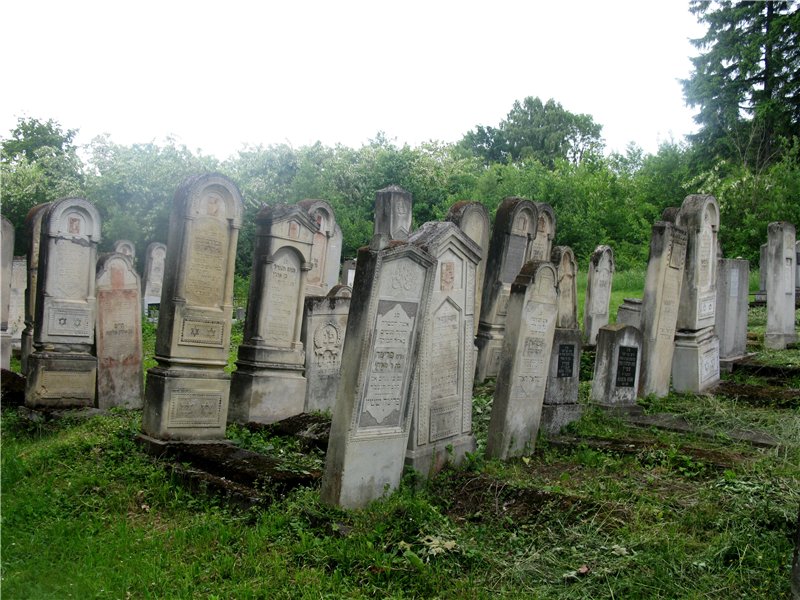
We return to the familiar crossroads and begin to explore the historic center of Storozhynets. On the corner of Khmelnytsky and Hrushevsky streets is the town hall, a symbol of most western Ukrainian cities. Built in 1905, Storozhynets Town Hall is the second largest in Bukovyna after Chernivtsi Town Hall in terms of both height and beauty. The two-story red-tiled town hall is crowned by a two-tiered tower with a clock on the pediment between the first and second tiers. On the second tier there is an observation deck with a steep staircase. The town hall culminates in a decorative dome with a lantern and a spire. Just like 100 years ago, today the Storozhynets Town Hall is a symbol of local government in the city: the city council is located here.

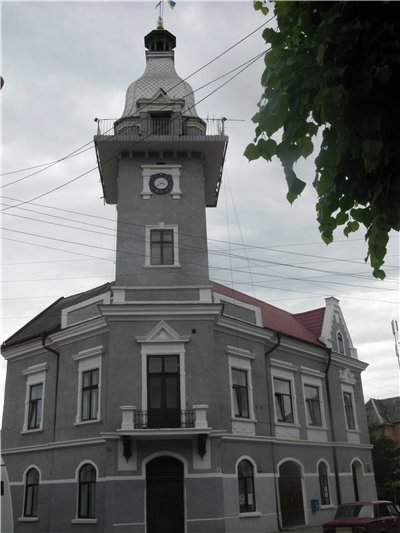
Around the town hall there is a cluster of old houses that delight the eye with their facades and decorations. A small Hrushevskoho Street will lead us to the most original building in the city - the Church of St. Anne. Its tall Gothic tower with a clock can be seen from many parts of Storozhynets. The catalog of local architectural monuments of the Chernivtsi region indicates the date of construction of the church as 1794. This is probably the date of construction of its predecessor, a wooden church. According to other sources, the wooden church was built between 1853 and 1857 at the expense of Georg Flondor and Ignazio Barti, the chaplain of Krasna (modern Krasnoilsk).
At the beginning of the twentieth century, a stone church in the Neo-Gothic style was built on the site of the wooden shrine, which we see today. In 1905, the church was consecrated by Archbishop J. Weber. In the 60s of the twentieth century, the church was closed by the communist authorities, and in 1990 it was returned to the faithful. To the left of St. Anne's Church is the Orthodox St. George's Church. It was the first large church in the city. Built in 1829 at the expense of Catherine Garste, the wife of Mykola Flondor, the church still impresses with its grandeur and monumentality. From the church, walk one block down Shevchenka Street to the intersection with Yuriy Fedkovych Street. If we turn left and walk a few blocks, we will see a two-story building under a tiled roof with two folds. This is the train station. Like many other railway station buildings in Bukovyna, the Storozhynets station, built in the late nineteenth century after the opening of the Hlyboka-Storozhynets-Berehomet nad Seret state railway, incorporated the best traditions of Austrian "station" architecture.
If you turn right from Shevchenka Street to Fedkovych Street, you will soon see the building of the former synagogue on the left side of the street. As in most towns in Bukovyna, Jews played a significant role in the social life of Storozhynets in the nineteenth century. At the beginning of the century, they made up one third of the town's population, and in the 80s of the nineteenth century, almost half. As a rule, Jews were traders, craftsmen, owners of industrial enterprises, shops, and sometimes officials. At the end of the century, the mayor of the city was a Jew, Isidor Katz, who did much for the development of the city.  Jews held their services in small prayer houses. It was only at the end of the nineteenth century that a large synagogue, a temple with a number of Jewish religious buildings, including a mikvah (ritual bath), was built in 1890-1900 on the charitable contributions of believers. From then until the outbreak of World War I, the temple was the center of Jewish life in the city. The Russians, who captured the city three times, turned the synagogue into a military warehouse for the Russian army, and destroyed the mikvah. After the war, however, the temple was repaired at the expense of the Orenstein family descendants.
Jews held their services in small prayer houses. It was only at the end of the nineteenth century that a large synagogue, a temple with a number of Jewish religious buildings, including a mikvah (ritual bath), was built in 1890-1900 on the charitable contributions of believers. From then until the outbreak of World War I, the temple was the center of Jewish life in the city. The Russians, who captured the city three times, turned the synagogue into a military warehouse for the Russian army, and destroyed the mikvah. After the war, however, the temple was repaired at the expense of the Orenstein family descendants.
After World War II, only 10 Jewish families remained in Storozhynets. The rest were murdered by the Nazis or deported to Siberia by Moscow's decision. The synagogue has not been used for worship since then. The converted building of the former temple now houses many institutions, including a sports school. We will continue our exploration of the religious architecture by turning left from Shevchenka Street onto Bohdana Khmelnytskoho Street. One block after the railroad crossing, a two-story house of worship is located on the left side of the street. This is an evangelical church that was built in 1909-1911 by Leipzig architect Zaulek at the request of the German community of Storozhynets, which was then led by Max Weidauer.
On the right side of Khmelnytskoho Street is the Yunist City Park, behind which Oleksandr Matrosova Street begins on the left before the bridge over the Seret. After driving a block, on the right side of the street you will see a new wooden church, the Holy Transfiguration Church (Holy Martyrs of the Kingdom), built in 2001. Fresh wooden walls and a tin-covered roof with a tower above the narthex will hardly attract the attention of fans of wooden architecture. The architectural techniques used to build the church bear little resemblance to the Bukovynian traditions of building wooden churches, but rather reflect some incomprehensible modernity.  However, there is a real old wooden church in Storozhynets. It is located on the outskirts of the town, in a place called Maidan. To see the church, you need to continue down Bohdana Khmelnytskoho Street in the direction of Krasnoilsk. The fourth turn on the left after the bridge over the Seret, 2nd Bohdan Khmelnytsky Lane, will lead to the Romanian cemetery, next to which the church is located.
However, there is a real old wooden church in Storozhynets. It is located on the outskirts of the town, in a place called Maidan. To see the church, you need to continue down Bohdana Khmelnytskoho Street in the direction of Krasnoilsk. The fourth turn on the left after the bridge over the Seret, 2nd Bohdan Khmelnytsky Lane, will lead to the Romanian cemetery, next to which the church is located.
Source: http://gromady.cv.ua/st/storozhynetsj/
Які туристичні (пішохідні) маршрути проходять через/біля Storozhynets?
Пропонуємо пройти такі туристичні (пішохідні) маршрути через/біля Storozhynets: пер. Німчич - Протяте Каміння, Смугарські водоспади, с. Шепіт, через г. Яровиця, г. Пнів'є, г. Масний Присліп до с. Шибене, с. Шепіт – г. Яровиця, с. Нижній Яловець, через г. Яровиця до с. Шипіт, с. Шепіт, через г. Яровиця, г. Пнів'є, г. Тарниця до с. Пробійнівка
